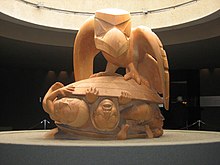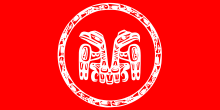Haida (people)

The Haida are an Indian people in Canada and thus one of the more than 600 First Nations in the country.
Their traditional settlement area extends over some coastal regions of British Columbia (especially the Haida Gwaii archipelago ) and southeastern Alaska . Their language, Haida , which is only spoken by a few hundred people today, was previously mistakenly assigned to the Na Dené language group. Today it is viewed by the majority as an isolated language .
The Haida warriors were feared; their ocean-going canoes made them dominant, especially at sea. They lived in long houses , which should not be confused with those of the Iroquois . The potlatch ( giving chinook ) is also known .
Since the smallpox epidemic of 1862 , the number of Haida has decreased from 8,000 to around 2,000 today. As a result of the dramatic decline in population, the traditional way of settling in villages with one register clan was given up in favor of villages with several clans .
The Haida are known for their imposing totem poles .
history
Early history
At the end of the last ice age, the Hecate Strait , which separates what is now Haida Gwaii from the mainland, was dry. Only around 8000 BC The sea level rose and today's Haida Gwaii Islands were separated from the mainland. Even parts of the coastal plains were temporarily under water. Numerous myths are reminiscent of this radical change in the landscape, which also forced relocations. In the Haida tradition, for example, there are memories of settlements on the west coast of the islands.
In the transition zone between sea and land, simple tools from the time immediately after the retreat of the ice were actually found. What is striking here is the large number of microblades . These tiny blades were probably part of composite tools, so they were connected as points and blades with holders made of wood, antler or bone. This technique was known in Northeast Asia 20,000 years ago and may have come to Alaska 12-15,000 years ago . It is noticeable that in northern British Columbia there is a lack of spearheads machined on both sides.
Apparently the Haida mastered sailing the Pacific very early on and adopted the very small stone blades known as microblades . They were mostly made from obsidian , a type of glass of volcanic origin. The origin of this material can be precisely determined, and so one gets an impression of the early spaciousness of trade relations.
From their northern island fortress, the Haida not only engaged in trade but also war. When the first Europeans arrived in the region at the end of the 18th century, they had long been considered feared warriors from Alaska to California .
The natural environment offered not only salmon and marine mammals , but also shellfish that only had to be picked up from the beach. It was above all the spatial isolation and this stability of the food base that made the Haida one of the longest established peoples. This made them an exception even on the Pacific coast, because very early on they developed permanent villages that were inhabited all year round. From early on, the excess food was enough to feed a group of specialists who could concentrate on making tools, ritual carvings, magnificent plank houses and canoes.
While the artifacts from around 5000 BC Still very different from those on the mainland, those from the time around 1000 BC. Chr. To Chr. Born - probably through trade contacts - have already become much more similar to those of the Tlingit and Tsimshians. However, archaeological research among the Haida is extremely difficult, as many Haida fear that the peace of their ancestors could be disturbed.
The Haida consisted of two social groups, moieties called raven and eagle. The raven moiety consisted of 22 lineages , the eagle moiety of 23 of these families. In an older phase each family probably lived in its own village, but these boundaries have probably dissolved, so that many lineages were represented in each village. Marriage was only possible between moieties, not within one's own moiety, with the children belonging to the mother's moiety.
The access rights to resources such as fishing grounds, hunting and collecting areas, but also house locations, depend on this affiliation. In addition there were legends, dances, chants and names, which at the same time signaled a clear hierarchy and belonged only to the owner or authorized him to practice a ritual.
30 to 40 people lived in each house, up to ten families and more. Large chiefs' houses could even accommodate over 100 people. Every lineage could submit itself to the authority of a chief who would also lead in the event of war. The head of a town (town chief) presided over the wealthiest and most recognized lineage. But a warrior endowed with even greater respect could also overtake him.
There was a fierce rivalry between Chief Ninsingwas and Chief Skidegate, which also resulted in deadly clashes. However, the heredity of the lines along the feminine side largely prevailed. Usually the son of the chief's eldest sister followed in his office.
Heredity also determined public appearance; B. Festivities and Potlatches . Anyone who had never given a potlatch was considered a simple tribesman, plus slaves, who were mostly prisoners of war or their descendants.
For this reason alone, the potlatch was the most important festival. They made the most important events such as marriage, naming or death visible, or the erection of a totem pole or a house, publicly, but they also served to distribute the wealth of the upper class to those who had limited access to their resources.
Haida and Ecotrust Canada began to systematically record and map cultural artifacts in 2003. One of the main goals was the creation of a map of the Culturally Modified Trees , which, thanks to methodological advances, represent one of the most important sources for the early history of the non-literate cultures.
Contacts with Europeans
One of the most profound changes was not in contact with Europeans and their goods, but in the fact that the Haida, like all indigenous people, were vulnerable to epidemics of disease. Above all, these were smallpox, with which the Haida first came into contact in the 1780s. The disease was called Tom Dyer , probably after the first name of a Briton to whom the previously unknown phenomenon was attributed. Smallpox probably killed more than three quarters of the Haida. At least as catastrophic was the outbreak of the 1862 epidemic , which a man brought in from San Francisco in April of that year .
The national park and the timber industry
Between the Haida and the timber companies, above all Weyerhaeuser , there were always disputes that led to the blockade. When the company sold forest licenses for $ 1.2 billion without complying with the Supreme Court's consultation obligation, and blamed it on the government, Haida moved to Seattle in front of the local headquarters.
"Destructive Society"
The social psychologist Erich Fromm analyzed the willingness of 30 pre-state peoples, including the Haida, to use ethnographic records to analyze the anatomy of human destructiveness . In conclusion, he assigned them to the “destructive societies” whose cultures are characterized by a lack of community spirit with pronounced individuality (egoism, possession, rivalry, envy) and by a hostile and tense mood (insidiousness, mistrust, fear of the future). Their social structure was strictly hierarchical, offenses were punished with harsh punishments, the ideological worldview determined the upbringing of children and led to destructiveness, blind aggression and cruelty within the people and towards others. Imperialist aspirations and wars of aggression are common phenomena in destructive societies.
See also: "War and Peace" in pre-state societies
art
For many authors, the often monumental Haida art is considered the culmination of the art of the peoples of the northwest coast. However, the monumental style of the totem poles did not develop until the colonial era. It results from an outbid competition, as can also be seen in the potlatch. The two-dimensional art of the Haida, on the other hand, is characterized by classically proportioned ovaries and strong contour lines ( formlines ). Views of bodies are segmented and rearranged in the area until they completely fill it. The colors black and red are used almost exclusively, large black areas are always resolved. Many two-dimensional views depict Qonanqada , a mythical being who rules under the waters.
Important Haida artists of today were or are, among others, Charles Edenshaw , Bill Reid , Jim Hart and Jay Simeon .
See also
literature
- William Henry Collison: In the Wake of the War Canoe. A Stirring Record of Forty Years' Successful Labor, Peril and Adventure amongst the Savage Indian Tribes of the Pacific Coast, and the Piratical Head-Hunting Haida of the Queen Charlotte Islands. Musson Book Company, Toronto 1915 (Reprint based on the Toronto printing: Musson Book, Sono Nis, Victoria 1981 ISBN 0-919462-87-1 ).
- Thomas Geduhn: Own and foreign behavior patterns in the territorial history of the Haida. Holos Verlag, Bonn 1993, ISBN 3-86097-080-1 ( Mundus series Ethnology 71).
- Charles Lillard (Ed.): The Ghostland people. A documentary history of the Queen Charlotte Islands, 1859–1906. Sono Nis Press, Victoria 1989 ISBN 1-55039-016-3 .
- Charles Lillard: Revenge of the Pebble Town People: A Raid on the Tlingit. In: Manoa. Volume 10, No. 2, 1998 ISSN 1045-7909 pp. 108-109, 111-121.
Web links
Individual evidence
- ↑ On the importance of slavery on the North American Pacific coast between Alaska and the Columbia River cf. Leland Donald: Aboriginal slavery on the Northwest Coast of North America. University of California Press, Berkeley 1997.
- ^ Wilson Duff: The Indian History of British Columbia: The Impact of the White Man. Royal British Columbia Museum, Victoria 1997, p. 58.
- ↑ Paul Shukovsky: Haida open front Seattle in forest fight. Weyerhaeuser riles tribe with rich deal to sell logging rights. in: seattlepi.com, April 20, 2005.
- ↑ Erich Fromm: Anatomy of human destructiveness . Translated by Liselotte and Ernst Mickel. Rowohlt, Reinbek 1977, ISBN 3-499-17052-3 , pp. 191, 193.
- ^ Hilary Stuart: Looking at Indian Art of the Northwest Coast. Douglas & McIntyre, University of Washington Press, Vancouver 1979, pp. 104-106.






